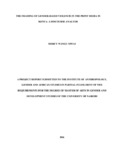| dc.description.abstract | This project was primarily concerned with the framing of gender-based violence in the mainstream print media in Kenya. Four daily English language newspapers, namely, Daily Nation, People Daily, The Standard and The Star as well as two weekly newspapers, that is, Saturday Nation and Sunday Nation provided the data presented in this project. The specific objects of this project were: An examination of how the mainstream print media frame the coverage of gender-based violence issues in Kenya, the degree of prominence given to the stories as well as the sources of information that the print media utilize when reporting gender-based violence in Kenya. This projected was guided by framing theory.
The stratified sampling technique was utilized to select articles that were printed between February 11th, 2016 and August 8th, 2016 and a total of 25 stories were analyzed from the sampled newspapers. Discourse analysis, with the help of a code sheet, was utilized in data collection and analysis concerning the type of stories, placement of the articles, size and space allocated to the stories, frequency and type of the frames used, prominence of the articles in the newspapers as well as the themes and sources of the information of the stories printed in the sampled newspapers.
The results of the study show that physical violence by men against women followed by female genital mutilation/cutting was the most frequently reported form of gender-based violence in the newspapers under review. However, the print media in Kenya continue to report gender-based violence stories especially if they are sensational and breaking news but without much efforts expended at follow-ups. In addition, gender-based violence stories are normally briefs and fillers in the newspapers, thus, extensive size and space need to be allocated to them.
Finally, although the print media usually highlights, informs and enlightens audiences about gender-based violence and its negative effects in society more needs to be done. | en_US |



